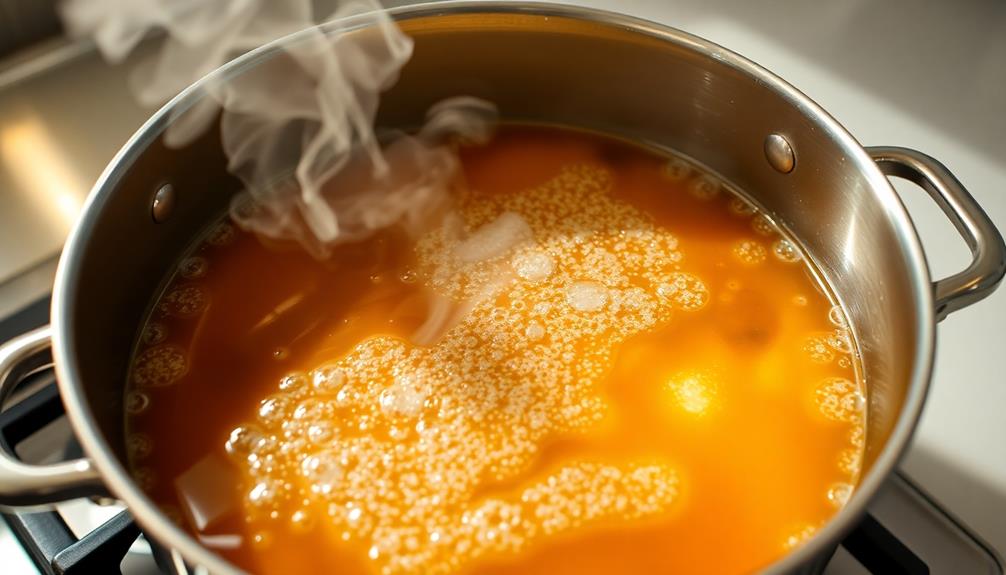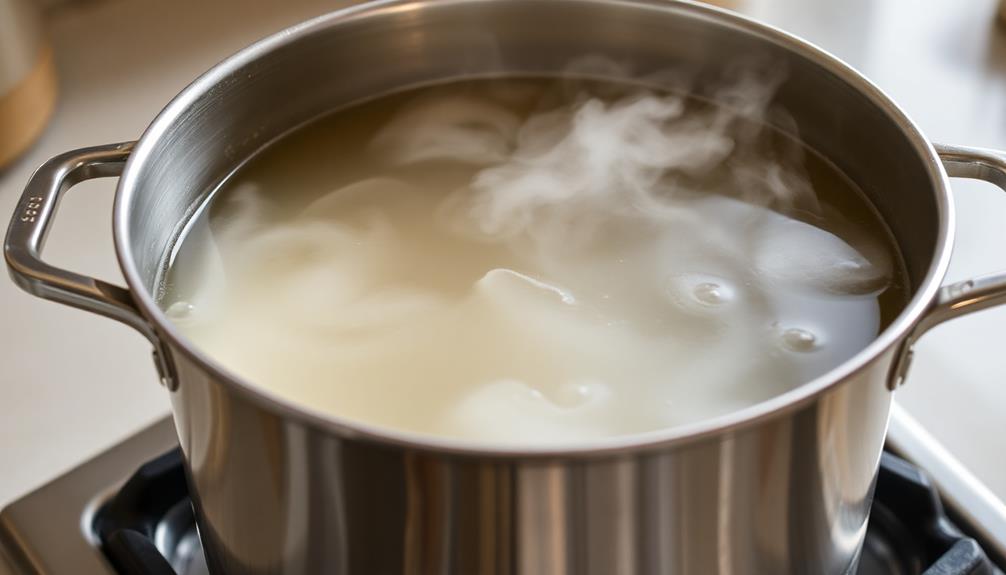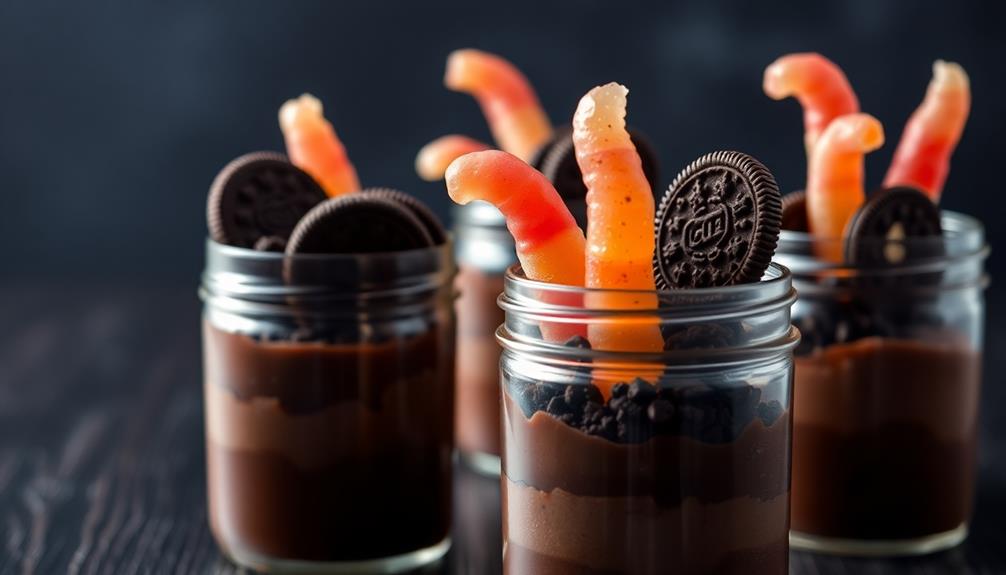Spiderweb soup is a unique dish with a fascinating history. It originated in early 20th century rural communities, where clever cooks utilized free spider webs as an ingredient. Over time, the recipe evolved, combining savory broth, tender chicken, and delicate spiderweb-like noodles. Today, it remains a beloved traditional dish, ideal for Halloween or adventurous culinary experiences. The recipe is straightforward, emphasizing creativity in presentation and seasoning. Serve it hot, showcasing the intricate flavors and visuals. This captivating dish is sure to impress your guests and leave them eager to learn more about its rich cultural traditions.
Key Takeaways
- Spiderweb Soup is a traditional dish with origins traced back to early 20th century rural communities where cooks used spider webs as a free ingredient.
- The dish combines a savory broth, tender chicken, and delicate spiderweb-like noodles, making it an ideal choice for Halloween or unique culinary experiences.
- The recipe requires simple ingredients and straightforward preparation, with an emphasis on creativity in presentation and seasoning to enhance the visual appeal.
- Serving suggestions include pairing the soup with crusty bread or crackers for a complete meal, and highlighting the careful preparation and harmonious blend of textures.
- Mastering the unique technique of Spiderweb Soup showcases culinary talent and creativity, as personal touches can be added to the dish.
History
According to historical records, spiderweb soup's origins can be traced back to the early 20th century.
It's believed the dish first emerged in rural communities, where resourceful cooks utilized readily available ingredients to create a hearty, nutritious meal. At the time, spider webs were seen as a free and abundant natural resource, easily gathered from around the home.
The earliest known recipes called for simmering the collected webs in a simple broth, often enhanced with whatever vegetables or meat scraps were on hand.
This practical approach allowed families to stretch their food supplies during times of scarcity. Over the decades, the soup evolved as cooks experimented with different flavor combinations and preparation methods.
Today, spiderweb soup remains a beloved traditional dish, with recipes passed down through generations.
While some may perceive it as unconventional, its enduring popularity speaks to the ingenuity and resourcefulness of the home cooks who've kept this unique culinary tradition alive.
Recipe
Spiderweb Soup is a delightfully creepy and delicious dish perfect for Halloween or any time you're craving a unique culinary experience. The combination of savory broth, tender chicken, and spooky spiderweb noodles creates a truly mesmerizing meal.
To make this ghoulish delight, you'll need to put on your witch's hat and embrace your inner culinary sorcerer. With a few simple ingredients and a bit of kitchen witchcraft, you'll be able to conjure up a spellbinding soup that will have your guests begging for more.
Ingredients:
- 4 cups chicken broth
- 2 boneless, skinless chicken breasts, diced
- 1 package spiderweb or round egg noodles
- 1 onion, diced
- 2 cloves garlic, minced
- 2 carrots, peeled and sliced
- 1 teaspoon dried thyme
- Salt and black pepper to taste
Instructions:
In a large pot, bring the chicken broth to a simmer over medium heat. Add the diced chicken, onion, garlic, carrots, and thyme.
Cook for 15-20 minutes, or until the chicken is cooked through and the vegetables are tender. Add the spiderweb noodles and cook for an additional 8-10 minutes, or until the noodles are tender.
Season with salt and black pepper to taste.
Tips:
For an even spookier presentation, try adding a few drops of black food coloring to the broth to create a darker, more ominous hue.
You can also garnish the soup with fresh parsley or chives to mimic the appearance of a spiderweb. Serve with crusty bread or crackers for a truly haunting meal.
Cooking Steps
First, bring a large pot of water to a boil.
Once it's boiling, toss in the chopped onions and let them cook for a bit.
Next, add the spiderweb noodles and your favorite seasoning, then let it all simmer for about 15 minutes.
Easy peasy!
Step 1. Boil Water in Large Pot

The large pot's contents should be brought to a vigorous boil. Fill the pot with water, enough to cover the spiderweb ingredients you'll be adding later.
Place the pot on your stovetop and turn the burner to high heat. Keep a close eye on the pot, as it won't take long for the water to start bubbling.
Once you see a steady stream of large, rolling bubbles breaking the surface, the water has reached a full boil. Reduce the heat slightly to maintain this vigorous boil, but don't let the water come to a rolling, rolling boil, which can make the soup too agitated.
The goal is a lively, but controlled, boil. This step ensures the soup's base is hot enough to cook the ingredients thoroughly.
With the water now at a perfect boil, you're ready to add the spiderwebs and begin the next phase of this bewitching recipe.
Step 2. Add Chopped Onions

Once the water has reached a vigorous boil, you can begin adding the chopped onions. Carefully drop the onions into the pot, ensuring they're evenly distributed. The onions will immediately start to sizzle and release their aromatic flavors, filling your kitchen with a savory scent.
As the onions cook, they'll become translucent and tender, adding a delightful sweetness to the broth. Stir the onions occasionally with a wooden spoon to prevent them from sticking to the bottom of the pot.
Cook the onions for 5-7 minutes, or until they reach your desired level of doneness. Be mindful not to let them burn, as this can impart a bitter taste to the soup. Once the onions have reached the perfect texture, you can move on to the next step in the recipe.
Step 3. Add Spiderweb Noodles

After the onions have been sautéed to perfection, it's time to add the spiderweb noodles to the pot. These unique, delicate noodles will bring a touch of whimsy to your spiderweb soup.
Gently drop the noodles into the simmering broth, taking care not to break them. As they cook, the noodles will begin to expand and resemble intricate spiderwebs, adding both texture and visual interest to the dish.
Stir the noodles occasionally, ensuring they cook evenly. The spiderweb shape will hold the flavorful broth, allowing each bite to be a delightful experience.
Be patient as the noodles reach the perfect al dente texture, around 8-10 minutes. Once cooked, the noodles should be tender yet still maintain their distinctive shape.
Ladle the spiderweb soup into bowls, making sure each serving includes several of the delicate, web-like noodles. This whimsical addition will delight your guests and make your spiderweb soup truly one-of-a-kind.
Step 4. Add Seasoning

With the spiderweb noodles now gently swirling in the simmering broth, it's time to season the spiderweb soup. First, add a pinch of salt and a dash of pepper. These classic seasonings will help bring out the natural flavors in the broth and noodles.
Next, consider adding a sprinkle of dried herbs like thyme or oregano. Their earthy notes will complement the web-like texture of the noodles. For a bit of zing, stir in a squeeze of lemon juice or a splash of vinegar. This will brighten up the soup and cut through any richness.
Don't be afraid to taste and adjust the seasoning as needed. The goal is to find the perfect balance of flavors that will make your spiderweb soup truly irresistible.
With just a few simple additions, you'll have a delightfully seasoned meal that's sure to impress.
Step 5. Simmer for 15 Minutes

Simmer the spiderweb soup for 15 minutes, allowing the flavors to meld and the noodles to soften. During this time, the delicate spiderweb-like pasta will absorb the rich broth, creating a comforting texture.
Stir the soup occasionally to ensure even cooking and prevent sticking. The aroma of the simmering spices and vegetables will fill your kitchen, whetting your appetite.
As the soup simmers, the vegetables will become tender and the flavors will deepen. The noodles will also continue to soften, developing a satisfying, slurpable consistency.
Be careful not to overcook, as you want the noodles to retain a bit of bite. After 15 minutes, the soup should be ready to serve, with the spiderweb pasta perfectly cooked and the overall dish harmonized in flavor.
Ladle the spiderweb soup into bowls, making sure each portion contains the delicate, web-like noodles. The soup is now ready to enjoy, its flavors having had time to fully develop during the simmering process.
Final Thoughts
The spiderweb soup's final moments call upon you to savor its intricate flavors.
Take a moment to appreciate the captivating visual presentation and the harmonious blend of textures. This soup is a true work of art, requiring both skill and patience to execute perfectly.
As you take your last few bites, reflect on the journey that led you here.
The painstaking preparation, the careful monitoring of the simmering broth, and the delicate assembly of the spiderweb design – each step has contributed to the masterpiece before you.
Revel in the sense of accomplishment, knowing that you have mastered a unique and challenging culinary feat.
Frequently Asked Questions
Is Spiderweb Soup Safe to Consume?
Consuming spiderweb soup wouldn't be safe. While spiders themselves aren't toxic, their webs can harbor harmful bacteria and contaminants that could make you sick.
It's best to avoid eating anything that may have been in contact with spider webs. Focus on preparing tried-and-true recipes from reliable sources to keep your meals safe and delicious.
When it comes to food, it's always better to err on the side of caution.
Where Can I Purchase the Spiderweb Ingredients?
You're looking to purchase ingredients for a special dish, huh?
While spiderwebs mightn't be the most common cooking material, there are a few places you can find them.
Check with your local nature preserve or insect enthusiast club – they may be able to point you in the right direction.
Just be sure to gather the webs ethically and safely.
With a little creativity, you can create all sorts of unique culinary creations!
How Long Does Spiderweb Soup Last in the Refrigerator?
Spiderweb soup lasts about 3-4 days in the fridge.
That's how long you can safely keep it stored before it starts to go bad.
Be sure to store it in an airtight container and eat it within that timeframe for the best quality and flavor.
You don't want to let it sit too long or it could develop funky smells and tastes.
Enjoy your spiderweb soup while it's fresh!
Can Spiderweb Soup Be Frozen for Later Use?
Yes, you can definitely freeze spiderweb soup for later use!
Once it's cooled, simply pour the soup into an airtight container or freezer bag, leaving a bit of space at the top for expansion.
It'll keep in the freezer for up to 3 months.
When you're ready to enjoy it again, just thaw it in the fridge overnight and reheat on the stove.
Easy peasy – now you can savor that delicious spiderweb flavor anytime!
Is Spiderweb Soup Suitable for Vegetarians or Vegans?
Spiderweb soup isn't the most vegetarian-friendly dish, as it typically contains spider broth.
However, you can easily make a veggie-based version that's just as delicious. Use a vegetable stock or broth as the base, then add your favorite veggies and seasonings.
Just be sure to avoid any animal products like honey or bone broth.
With a few simple swaps, you can enjoy this unique soup without compromising your dietary needs.











